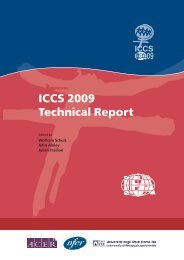Teacher Education and Development Study in Mathematics - IEA
Teacher Education and Development Study in Mathematics - IEA
Teacher Education and Development Study in Mathematics - IEA
Create successful ePaper yourself
Turn your PDF publications into a flip-book with our unique Google optimized e-Paper software.
42<br />
TEACHER PAY AND STUDENT MATHEMATICS ACHIEVEMENT<br />
et al., 2007; Ehrenberg & Brewer, 1995; Ferguson & Ladd, 1996; Goldhaber & Anthony,<br />
2004; Rivken et al., 2005; Wright et al., 1997. For studies relat<strong>in</strong>g to Mexico, see Luschei,<br />
2005; Santibañez, 2002.) Based on the grow<strong>in</strong>g literature which holds that teacher<br />
ability, say <strong>in</strong> mathematics, <strong>in</strong>fluences student mathematics learn<strong>in</strong>g, the capacity of<br />
education systems to recruit <strong>in</strong>dividuals with higher mathematics abilities <strong>in</strong>to teach<strong>in</strong>g<br />
should result <strong>in</strong> better average performance <strong>in</strong> mathematics.<br />
If higher relative salaries for teachers do attract <strong>in</strong>dividuals with higher ability <strong>in</strong>to<br />
teach<strong>in</strong>g, then it seems likely that <strong>in</strong> those countries with more unequal <strong>in</strong>come<br />
distributions <strong>and</strong> with high premiums for mathematics ability, it will be relatively more<br />
costly to conv<strong>in</strong>ce higher ability people to enter teach<strong>in</strong>g. This premise assumes, of<br />
course, that higher teacher pay does <strong>in</strong>crease the recruitment of teachers with higher<br />
ability. While this assumption is crucial to our premise, it is also controversial, at least<br />
among educational economists.<br />
When we regressed the teacher salary ratios for men <strong>and</strong> women on the G<strong>in</strong>i<br />
coefficients for each country (see Table 8), we found a negative relationship between<br />
male teacher salary ratio <strong>and</strong> <strong>in</strong>come <strong>in</strong>equality (as we had expected) <strong>and</strong> a negative<br />
relationship between the female teacher salary ratio <strong>and</strong> the G<strong>in</strong>i. However, neither of<br />
these relationships was statistically different from zero (Table 9). When we controlled<br />
for GDP per capita, the results did not change appreciably. The relative salaries paid<br />
to teachers, therefore, do not appear to relate to <strong>in</strong>come distribution, a f<strong>in</strong>d<strong>in</strong>g that<br />
counters our hypothesis.<br />
One reason why relative teacher salaries may not relate to overall <strong>in</strong>come distribution is<br />
that the salaries of university graduates are generally found <strong>in</strong> the upper-20%-<strong>in</strong>come<br />
bracket <strong>in</strong> most societies, <strong>and</strong> <strong>in</strong> an even higher bracket <strong>in</strong> lower-<strong>in</strong>come societies.<br />
So, although, <strong>in</strong> most countries, the G<strong>in</strong>i coefficient does a particularly good job<br />
of captur<strong>in</strong>g changes at the upper end of the distribution, it <strong>and</strong> other measures of<br />
<strong>in</strong>come distribution ma<strong>in</strong>ly capture differences between how much professionals as a<br />
group earn <strong>and</strong> how much less-educated wage-workers as a group earn <strong>in</strong> lower-pay<strong>in</strong>g<br />
occupations. The G<strong>in</strong>i thus does not do well <strong>in</strong> captur<strong>in</strong>g the differences among the<br />
salaries of various k<strong>in</strong>ds of professionals.<br />
Because the ratio of teacher salaries to the salaries of mathematics-oriented professions<br />
is apparently unrelated to the variation <strong>in</strong> <strong>in</strong>come distribution (or GDP per capita)<br />
across countries, it is likely that this ratio is a function of some variable that we have not<br />
measured. This could be, for example, the value that the society places on education, the<br />
strength of teachers’ unions, or even how much mathematics learn<strong>in</strong>g those who enter<br />
teach<strong>in</strong>g have experienced relative to those work<strong>in</strong>g as scientists <strong>and</strong> eng<strong>in</strong>eers.<br />
Some of these explanations are difficult to unravel. For example, a society may place<br />
a high value on education <strong>and</strong> pay teachers relatively high salaries. In such a case, the<br />
teach<strong>in</strong>g profession is more likely to attract <strong>in</strong>dividuals with mathematics skills that<br />
are similar to those <strong>in</strong> mathematics-oriented professions. We can put this another<br />
way: when mathematics teachers are paid more equally than people engaged <strong>in</strong> other<br />
work requir<strong>in</strong>g high mathematics skills, graduates are more likely to choose whether<br />
to become teachers accord<strong>in</strong>g to how how they want to use their mathematics skills<br />
rather than accord<strong>in</strong>g to economic considerations. We would need to go <strong>in</strong>to a long<br />
history of the teach<strong>in</strong>g profession to underst<strong>and</strong> if mathematics skills preceded high<br />
relative salaries, or vice versa. Even if strong teachers’ unions were the explanation for<br />
higher relative salaries, this situation could be one that attracts <strong>in</strong>dividuals with higher

















